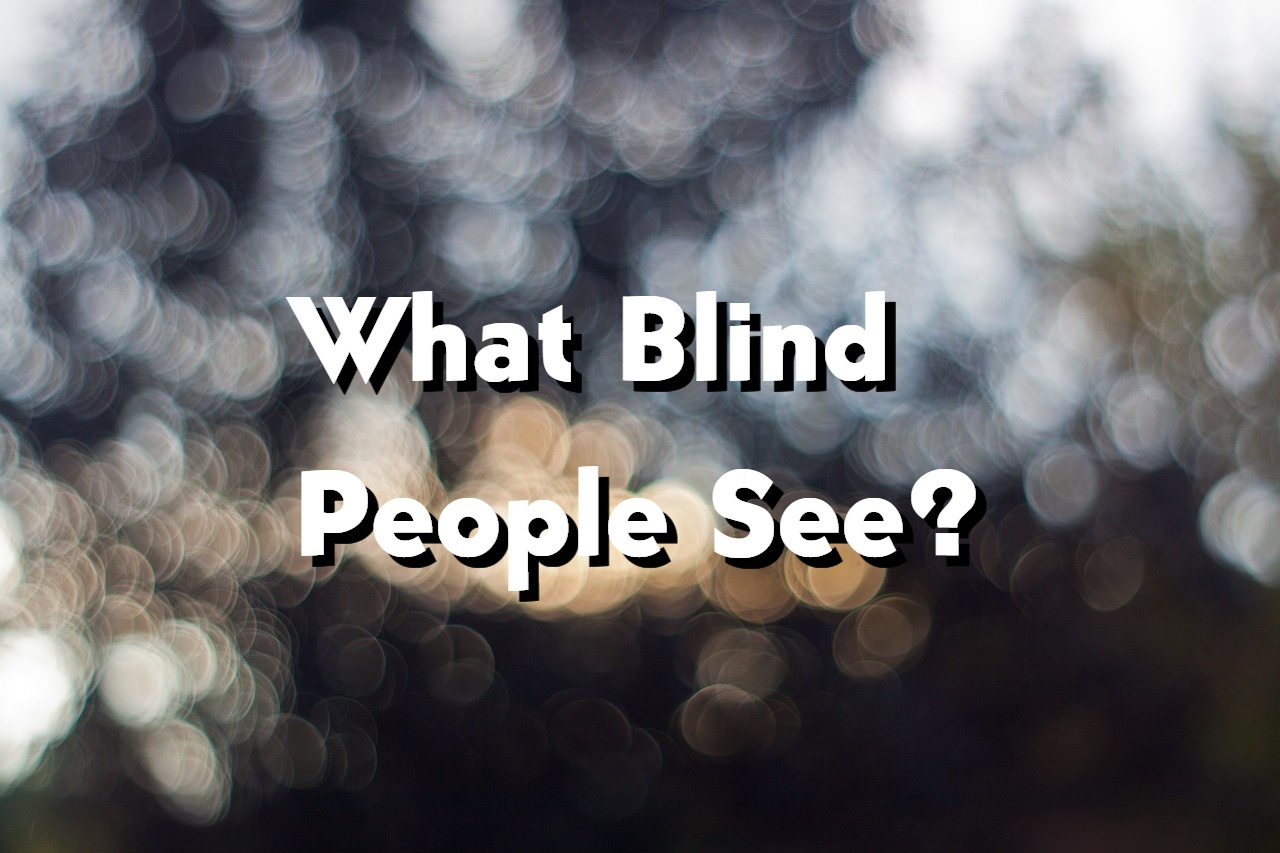What do Blind People See? Definition, Types
In the fascinating world of human experiences, understanding what blind people see takes us on a journey beyond the familiar realms of sight. From complete blindness to some perception of light, and from partial vision to color distinctions, each person’s encounter with the world without sight is like a special tale waiting to be told. In this exploration, we uncover the ways in which individuals, despite the absence of traditional vision, navigate and understand the world around them with ingenuity and resilience.
Blindness is a broad term that can refer to various degrees of visual impairment, ranging from low vision to complete blindness. It’s important to note that people who are blind do not “see” in the same way that sighted individuals do. The experience of blindness varies depending on the individual’s specific condition and whether they were born blind or became blind later in life.

Exploring the different types of blindness, such as congenital and acquired conditions or partial vision impairments, raises a curious question: What do blind people see? It’s like opening a door to a world where our senses play a unique role, showing us how people adapt and understand things without sight.
Types of blindness
- Total blindness (No Light Perception)
Total blindness, also referred to as complete blindness, is a condition where an individual has little to no functional vision. People who are totally blind do not perceive visual information, such as shapes, colors, or light. It is important to note that total blindness does not necessarily mean the absence of all senses; individuals who are blind often rely on their other senses, such as hearing, touch, and smell, to navigate and understand the world around them.
Total blindness can be congenital, meaning a person is born without the ability to see, or it can be acquired later in life due to various factors such as injury, disease, or degeneration. The experiences of individuals who are totally blind can vary, and they often develop adaptive techniques and skills to lead independent and fulfilling lives. Additionally, advancements in assistive technologies and support systems play a crucial role in enhancing the quality of life for individuals living with total blindness.
- Blindness with Light Perception
Blindness with light perception refers to a condition in which an individual has some degree of vision that allows them to perceive light but not necessarily distinguish shapes, objects, or details. In other words, they may be aware of the presence of light and changes in brightness but lack the ability to form visual images.
This form of visual impairment can occur due to various factors that affect the ability to process visual information, such as
- damage to the retina
- optic nerve
- other parts of the visual pathway
Individuals with blindness and light perception may not experience the visual world in the same way as those with normal vision, but they retain a sensitivity to light.
It’s important to recognize that the extent of light perception can vary among individuals, and some may have a more heightened awareness of light changes than others. People with blindness and light perception often rely on their other senses and adaptive techniques to navigate their surroundings, emphasizing the remarkable ways in which individuals with visual impairments engage with and adapt to the world around them.
- Low Vision or Partial Blindness:
Low vision, also known as partial blindness, is a condition in which an individual has some remaining vision but experiences significant visual impairment. Unlike total blindness, people with low vision retain a degree of functional vision, although it may be limited in various ways. Low vision can result from
- eye conditions
- diseases that cause visual acuity reduction
- visual field loss
- Difficulties with contrast and color perception
The specific challenges faced by individuals with low vision can vary widely, as the degree and type of visual impairment differ from person to person, such as
- difficulty reading small print
- recognizing faces
- distinguishing between similar colors
- peripheral vision or glare sensitivity
Adaptive strategies, assistive technologies, and visual aids play a crucial role in helping individuals with low vision make the most of their remaining sight. Examples include magnifiers, screen readers, and large-print materials. Rehabilitation programs and orientation and mobility training are also essential for enhancing independence and daily functioning for those with low vision.
Understanding and addressing the unique needs of individuals with low vision contribute to creating inclusive environments that support their independence and participation in various aspects of life. It highlights the importance of a multidisciplinary approach involving healthcare professionals, educators, and assistive technology experts to improve the quality of life for people with low vision.
- Color Blindness:
Color blindness, also known as color vision deficiency, is a condition where individuals have difficulty distinguishing certain colors. This is typically due to genetic factors affecting the photoreceptor cells, called cones, in the retina. Cones are responsible for detecting different wavelengths of light, allowing us to see a range of colors. While not a form of total blindness, color blindness provides insights into the specific mechanisms of visual perception and the impact of genetic variations.
- Cortical blindness:
Cortical blindness is a visual impairment that results from damage to the visual processing areas in the brain’s occipital cortex. Unlike other forms of blindness caused by issues in the eyes or optic nerves, cortical blindness is a neurological condition where the eyes may function correctly, but the brain cannot interpret visual information.
The occipital cortex is responsible for processing visual stimuli and transforming them into meaningful images. When this region is damaged due to injury, stroke, infection, or other neurological conditions, it can lead to cortical blindness. The severity and extent of visual impairment can vary, ranging from partial vision loss to complete blindness.
Interestingly, individuals with cortical blindness may still exhibit certain visual reflexes, such as pupil constriction in response to light, even though they cannot consciously see. This phenomenon underscores the distinction between the automatic, reflexive aspects of vision and the conscious perception of visual stimuli.
- Cortical blindness often comes with additional challenges, such as difficulties with spatial awareness, object recognition, and navigating the environment.
- Individuals with cortical blindness may develop compensatory mechanisms, relying on their other intact senses and memory to navigate their surroundings.
Rehabilitation and support for individuals with cortical blindness often involve strategies to enhance non-visual sensory cues, orientation and mobility training, and the use of assistive technologies. Understanding the complex interplay between neural pathways and vision in cases of cortical blindness contributes to ongoing research in neuroplasticity and potential avenues for rehabilitation.
- Congenital Blindness:
Congenital blindness is present from birth, and individuals with this condition have never experienced visual stimuli. The absence of visual input during critical developmental periods can impact the organization of the brain, leading to unique adaptations in other sensory modalities, such as heightened auditory and tactile perception.
The specific challenges faced by individuals with congenital blindness can vary widely. Some may have light perception or the ability to distinguish between light and dark, while others may have no visual perception at all. Early interventions, such as early exposure to tactile and auditory stimuli, can play a crucial role in supporting the overall development of congenitally blind individuals.
Education and rehabilitation programs tailored to the needs of individuals with congenital blindness are essential for promoting independence and providing skills for navigating the world. Braille literacy, orientation and mobility training, and the use of assistive technologies are common components of comprehensive support for those with congenital blindness.
- Acquired blindness:
Acquired blindness refers to the loss of vision that occurs later in life due to various factors such as injury, disease, or degeneration. Unlike congenital blindness, which is present from birth, acquired blindness involves individuals who have experienced sight but later encounter a significant reduction or complete loss of visual ability.
The causes of acquired blindness can vary widely and may include conditions such as age-related macular degeneration, glaucoma, diabetic retinopathy, or injuries to the eyes or optic nerves. The process of adapting to acquired blindness can be complex, as individuals must adjust to the sudden or gradual loss of visual input.
Rehabilitation programs and support services play a crucial role in helping individuals with acquired blindness develop new skills, navigate their environment, and maintain independence. Learning alternative techniques for daily activities, such as reading Braille, using assistive technologies, and orientation and mobility training, can significantly enhance the quality of life for those adapting to acquired blindness.

